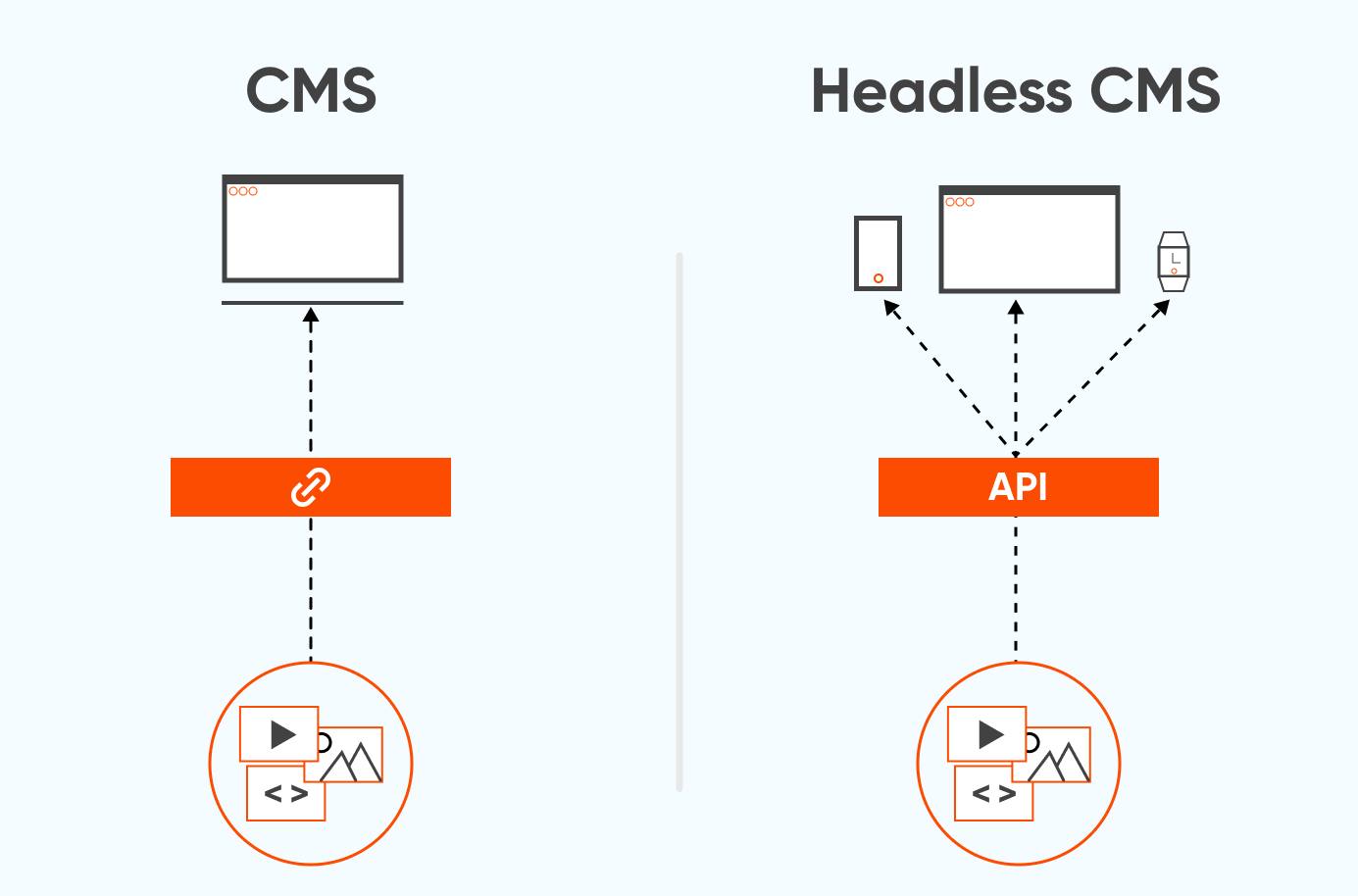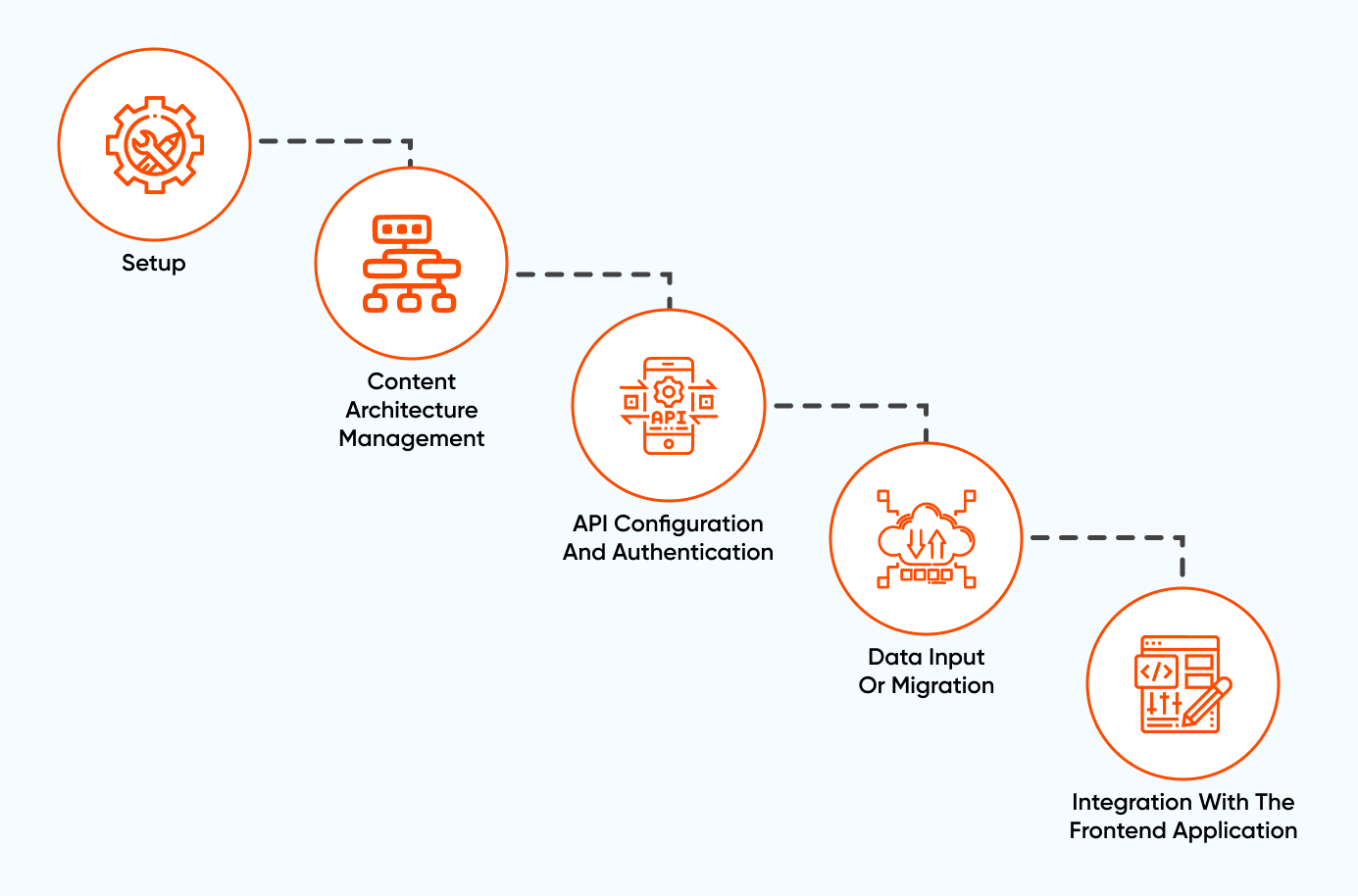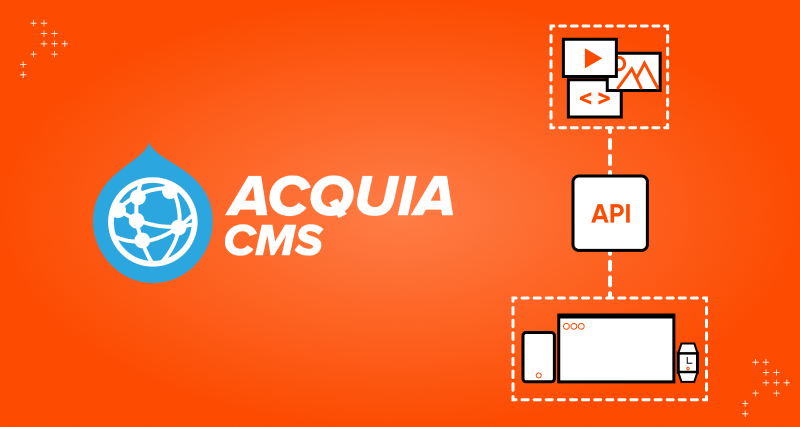Introduction
Traditionally, content is produced, managed, and stored in a CMS that is directly connected to just one website. But today’s digital experiences require a more flexible CMS that can publish to many channels simultaneously. This is why experts have predicted the market for headless CMS solutions to grow from $322 million in 2020 to $1.6 billion by 2027.
The right headless CMS can act as a robust backend content repository that will publish and personalize content and experiences across any tools used. This will help build omnichannel customer journeys.
With a headless architecture, development teams can constantly iterate and experiment with the website's frontend without compromising the backend or content creation. Keep reading to learn more about this new development in CMS technology.
What Is A Headless Application?
A headless CMS provides the content to multiple channels and devices with API endpoints. In this CMS, the frontend rendering content is decoupled from the backend, where the content is created, managed, and stored.
It combines attributes from traditional and headless CMSs, allowing users to create content and store it in a database. This content can be used flexibly through an existing, unified frontend rendering layer or retrieved by a separate frontend layer by APIs. This approach sets organizations to deliver content and experiences through any digital channels in their composable DXP stack.

Surprisingly, only a few headless CMS platforms serve both traditional and flexible CMS needs well. Acquia CMS is a Drupal-based CMS that assembles the best of Drupal’s headless offerings curated by Acquia. It also allows easy integration with other services provided by Acquia.
Understanding Acquia CMS
Acquia CMS is an open-source, composable CMS for creating, managing, and delivering personalized digital content and experiences. It is powered by Drupal and optimized for the Acquia platform.
It's a hybrid headless CMS that gives high-code, low-code, and no-code assembly. It is also characterized as an agile enterprise CMS that runs on a pre-packaged version of Drupal with enhanced capabilities exclusively maintained by Acquia.
Acquia CMS utilizes best practices from thousands of successful customer deployments. It is designed for marketing-focused organizations to speed up time to value. It also comes with:
- Automatic integrations with Acquia products like Acquia Search and Site Studio
- A set of starter UI components and a demo website built using Acquia Site Studio
- An expandable content model with preconfigured content types, media types, and taxonomy
- Configuration for security, performance, publishing workflows, and decoupled integrations
- Drupal modules that are regularly tested and updated
- Regular security upgrades and patches for ease of usability
Benefits Of Acquia CMS As A Headless Solution
Acquia CMS is built for organizations that deploy content across multiple channels. Other benefits of using Acquia CMS as a headless solution are:
Enhanced Omnichannel Experience
Traditionally, CMS platforms consist of backend publishing and a single frontend presentation layer. Acquia CMS, a headless system, sidesteps the frontend and uses APIs to publish content anywhere.
This allows organizations to craft digital experiences for not just desktops but also smartphones, tablets, and IoT smart devices. Acquia CMS pushes content to multiple platforms and saves authors from manually reformatting everything for different interfaces and duplicating work.
Arriva utilized the capabilities of Acquia CMS to overhaul its digital experience for customers searching for travel information and purchasing bus tickets. This was done by serving content through several APIs. This new and improved platform showed immediate and tangible results, with over 3 million users and 32% growth in year-over-year revenue.
Extensive Audience Reach
Acquia CMS has been built to deliver content seamlessly across several platforms and devices. This allows organizations to reach a wider audience and gain a competitive advantage in markets by easily meeting consumers where they are and engaging with them on their terms.
High Scalability
Acquia CMS is scalable as it has a decoupled architecture that features a frontend wholly pre-built with highly optimized static pages and assets. These assets can be used to directly serve from a Content Delivery Network (CDN), which reduces the costs, complexity, and risks associated.
Amdocs, a multinational corporation specializing in financial, communication, and media services, utilized this feature to eliminate its unnecessarily busy and complex website. Using Acquia CMS and Site Studio, the lean team was able to develop excellent digital experiences for business leaders who needed to understand the organization's directional thinking. After the initial discovery period, the site was delivered with impressive metrics in a mere eight weeks.
Ease Of Use For Developers
With the headless approach, developers get a lot of freedom and flexibility with the frontend coding framework and technologies. With a headless CMS, countless options exist for choosing the frontend framework, including React. Svelte, VueJS, Next.JS, and Angular. These options further increase when it comes to building, iterating, and innovating frontend experiences.
Acquia CMS comes equipped with underlying technology that's agile and easy to learn. APIs make managing and publishing content easy, and support for various webhooks and integrations is also provided to build digital experiences on top of the systems.
Future-Ready Capabilities
Because of its flexible nature, Acquia CMS is more future-ready than traditional systems. Developers can continue using this CMS without worrying about coding frameworks and technologies as the backend is decoupled from the frontend.
On top of this, developers can easily iterate and innovate frontend to the most recent standards and technologies. Acquia CMS can also be integrated with other services and products easily. For example, Acquia CMS supports JSON:API and Open API. It also integrates with tools like retool.com.
This future-ready capability is one of the biggest reasons headless CMSs like Acquia CMS are growing in popularity.
A Short Tale: nVent And Its Shift Towards Acquia
nVent is a global electrical company known for its reliability, innovation, and quality. The company struggled with the complexities and costs of having 3+ core business segments and 10+ established brands. nVent wanted to organize and consolidate its legacy websites into an enterprise platform that would make managing teams easier.
By implementing a low-code environment, nVent could quickly manage and maintain relevant, timely content. A shift towards Acquia CMS, Acquia Cloud Platform, Acquia Site Factory, and Acquia DAM made significant improvements to nVent's content and marketing deployment efficiency. This enabled the team to launch and promote products quickly.
Additionally, nVent saved over $1M per year in licensing fees, experienced a 23.19% increase in annual revenue from 2020 to 2021, and saw a 28.68% increase in year-over-year revenue. nVent was also able to automate many custom processes and inquiries, saving a significant amount of time for their sales reps and distributors.
How To Start Using Acquia CMS for Headless Applications
From the case study discussed above, it’s clear that Acquia CMS provides organizations with the greater flexibility and agility needed for constantly delivering exceptional digital experiences. But how can organizations start using Acquia CMS?
Find out the answer here.

Setup
Acquia CMS can be set up easily by following the instructions provided in the official repository. The developers can use the local development tool of their choice and configure Acquia CMS to work with the Headless starter kit. The developed application can then be moved to the hosted infrastructure of choice.
If the plan is to quickly set up a data backend for the application, developers can create an application on Acquia Cloud and use the ‘Acquia CMS - Headless Starter Kit’ as the template. This is done instead of using raw Drupal. Once the initial starting configurations are performed, the next step is to host the backend ready for serving data to the user-facing application. All of it comes bundled with the features offered by Acquia Cloud as a managed hosting and Drupal CMS.
Content Architecture Management
The next step is to set up the application's required data structures. This refers to the Content Types, Fields, and Taxonomies. These have to be defined per the application as this becomes the most important aspect of a project.
Since Acquia CMS is built upon, developers have access to various UIs for entity-based setup. One can easily add all the required architectural components in a one-time setup and prepare a base for content creation as well as consumption.
Acquia CMS provides various common content types of the box along with required fields and taxonomy vocabularies configured. These can be used directly in an application or customized before use.
Some of the common editorial workflows also come preconfigured with Acquia CMS, that are useful for enterprise-level content editing teams. Customizable workflows, revisional content pieces, and all modern editorial tools make content entry a straightforward and intuitive process.
API Configuration And Authentication
AMI management and security are the most important features of any headless application. With Acquia CMS, organizations can easily serve the data of choice (JSON, XML, CSV, or HTML) with common authentication constructs like OAuth, OAuth 2.0, JWT, and Basic Auth.
Built-in support for RESTful web services is also provided to ensure content delivery to a headless frontend. Constructs like GraphQL and JSON:API can be enabled on Acquia CMS to build the required APIs by the frontend application.
The caching system behind Acquia CMS is also quite flexible. It allows caching on the server to improve the performance of headless applications.
Data Input Or Migration
Acquia CMS has powerful content modeling capabilities that allow the creation of custom content types and fields. These can be used to structure the content for headless applications. This capability also allows organizations to quickly build data structures for applications without any custom codes.
The Drupal core provided by the migration framework can be leveraged to migrate data from other sources like SQL, CSV, JSON, and XML. Organizations can develop custom plugins or modify existing plugins to migrate as per the requirements. The Acquia Replatform tool can also be used to switch to Acquia CMS if the platform is hosted on Acquia Cloud.
Integration With The Frontend Application
Developers can use any technology for the frontend application because Acquia CMS exposes the necessary API in a generic manner. The majority of the features were created using industry-wide best practices for developing headless applications.
Additionally, Acquia CMS works well with software that makes use of Open API or Next JS. All the necessary contributed models and configurations are packed within Acquia CMS, and developers only need to enable the User Interface (UI).
The Conclusion
Acquia CMS, as a headless solution, provides unmatched flexibility and agility. It fulfills the need for a truly omnichannel digital content distributor, which is API-first and makes for a powerful backend repository.
But depending on an organization's needs and resources, a traditional CMS might suit too. Organizations that require a single source for managing the website and are only connected with a single digital property should opt for a traditional CMS.
Do you need more insight into choosing Acquia CMS for headless applications?
Schedule a call with the experts at Axelerant, who can help you get the most out of Acquia.

Gaurav Kapoor, Senior Drupal Engineer
Gaurav is a storyteller. An Arsenal FC fan, he also enjoys reading Amish Tripathi's works on Hindu Mythology. He has been spending every Friday evening at his favorite bar for more than two years now. Need a dose of sarcasm? He is your guy!

Simran Sethi, Content Marketer
Simran is an avid reader. She is an active runner, who also likes to swim, dance, and sing. For her, the meaning of life lies in the little things. Kindness, passion, and compassion are her life’s essential values.

 We respect your privacy. Your information is safe.
We respect your privacy. Your information is safe.



Leave us a comment